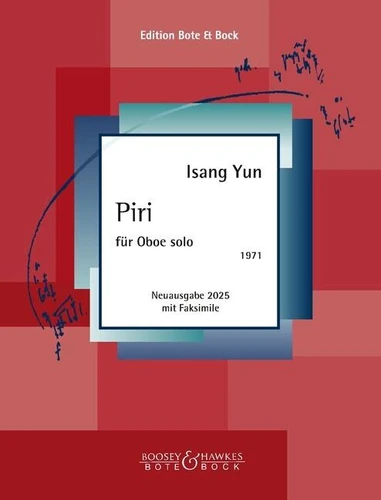Piri. Für Oboe solo
Par :Formats :
Actuellement indisponible
Cet article est actuellement indisponible, il ne peut pas être commandé sur notre site pour le moment. Nous vous invitons à vous inscrire à l'alerte disponibilité, vous recevrez un e-mail dès que cet ouvrage sera à nouveau disponible.
- Nombre de pages12
- PrésentationBroché
- FormatPartition
- Poids0.078 kg
- Dimensions23,1 cm × 30,3 cm × 0,0 cm
- ISBN978-3-7931-4605-6
- EAN9783793146056
- Date de parution20/08/2025
- ÉditeurBoosey & Hawkes Bote & Bock
Résumé
Piri came into being two and a half years after Isang Yun was imprisoned in Seoul. 'Piri' is the name of the traditional Korean oboe, of which at least three kinds exist in di ? erent sizes. They were (and are) mainly used in the traditional courtly and aristocratic music of Korea : the shorter 'se-p'iri' in the aristocratic song genres 'kagok' and 'kasa', the larger 'hyang-p'iri' in the court orchestra, and also in shamanistic ceremonies in which the 'p'iri' has a spiritual signi cance.
With Piri, Yun once again "transferred" the expressive character and tonal possibilities of a traditional instrument to a Western instrument, in this case to the oboe. Yun initially replaced the Korean and East Asian-influenced interval structures with those of the Western twelve-tone technique that he had acquired from Schoenberg's pupil Josef Rufer in Berlin. Nevertheless, in terms of gestures, phrasing, ornamentation, dynamics, and vibrato, he oriented himself on Asian music, which di ? ers substantially from European music.
Instrumentation : Oboe
With Piri, Yun once again "transferred" the expressive character and tonal possibilities of a traditional instrument to a Western instrument, in this case to the oboe. Yun initially replaced the Korean and East Asian-influenced interval structures with those of the Western twelve-tone technique that he had acquired from Schoenberg's pupil Josef Rufer in Berlin. Nevertheless, in terms of gestures, phrasing, ornamentation, dynamics, and vibrato, he oriented himself on Asian music, which di ? ers substantially from European music.
Instrumentation : Oboe
Piri came into being two and a half years after Isang Yun was imprisoned in Seoul. 'Piri' is the name of the traditional Korean oboe, of which at least three kinds exist in di ? erent sizes. They were (and are) mainly used in the traditional courtly and aristocratic music of Korea : the shorter 'se-p'iri' in the aristocratic song genres 'kagok' and 'kasa', the larger 'hyang-p'iri' in the court orchestra, and also in shamanistic ceremonies in which the 'p'iri' has a spiritual signi cance.
With Piri, Yun once again "transferred" the expressive character and tonal possibilities of a traditional instrument to a Western instrument, in this case to the oboe. Yun initially replaced the Korean and East Asian-influenced interval structures with those of the Western twelve-tone technique that he had acquired from Schoenberg's pupil Josef Rufer in Berlin. Nevertheless, in terms of gestures, phrasing, ornamentation, dynamics, and vibrato, he oriented himself on Asian music, which di ? ers substantially from European music.
Instrumentation : Oboe
With Piri, Yun once again "transferred" the expressive character and tonal possibilities of a traditional instrument to a Western instrument, in this case to the oboe. Yun initially replaced the Korean and East Asian-influenced interval structures with those of the Western twelve-tone technique that he had acquired from Schoenberg's pupil Josef Rufer in Berlin. Nevertheless, in terms of gestures, phrasing, ornamentation, dynamics, and vibrato, he oriented himself on Asian music, which di ? ers substantially from European music.
Instrumentation : Oboe

